If there is one type of food that defines the fall season, it’s pumpkins. Not only are the used to carve Jack-o-lanterns, but they’re also an excellent source of nutrition.
Their seeds make healthy snacks, and their flesh and pulp are a wonderful ingredient for all types of savory and sweet dishes, including pies, muffins, and soups. You can even eat mashed pumpkin, much like you would potatoes.
If you love pumpkins, you can successfully grow a patch in your very own backyard. In this guide, we’ll share some helpful tips that you can use to yield a wonderful crop of big, healthy pumpkins.
Pumpkin Quick Facts
| Quick Fact | Details |
|---|---|
| Best Time to Plant | Early June, after the risk of frost has passed |
| Soil pH | 6.0 to 6.5 |
| Soil Type | Rich, well-draining soil |
| Sunlight | Full sun (6-8 hours per day) |
| Watering | Deep, gentle watering once a week |
| Fertilizing | Every two weeks with a balanced fertilizer |
| Plant Spacing | 4-6 feet apart for bush varieties; 8-10 feet apart for vining varieties |
| Common Pests | Cucumber beetles, squash vine borers, aphids, cutworms, leafminers, and thrips |
| Companion Plants | Leeks, onions, and dill |
| Harvest Time | When rinds are hard and desired color is achieved; before the first heavy frost |
| Storage | Store in a cool, dry place with good air circulation |
History of Pumpkins
First, let’s take a look at the history of pumpkins, as we always find that knowing more about a plant helps you develop a greater appreciation for it.
- Pumpkins are a member of the Cucurbitacea (gourd) family.
- The word pumpkin is derived from the Greek word “peopon”, which in English, translates to “large melon”.
- The French word for “peopon” is “pompon” and the latter was changed to “pumpion” by the English.
- Colonists in America changed the word “pumpion” to the word “pumpkin”, the name that this vegetable is still called.
According to archeological evidence, pumpkins are considered a winter squash and are native to the southwest part of the United States, Mexico, and throughout South American countries, including Columbia, Ecuador, and Peru.
These hardy veggies have been cultivated since around 3,500 BC. Pumpkins and maize, or corn, are the oldest known crops grown in the western hemisphere. It is believed that Native Americans roasted strips of pumpkin on open fires for food.
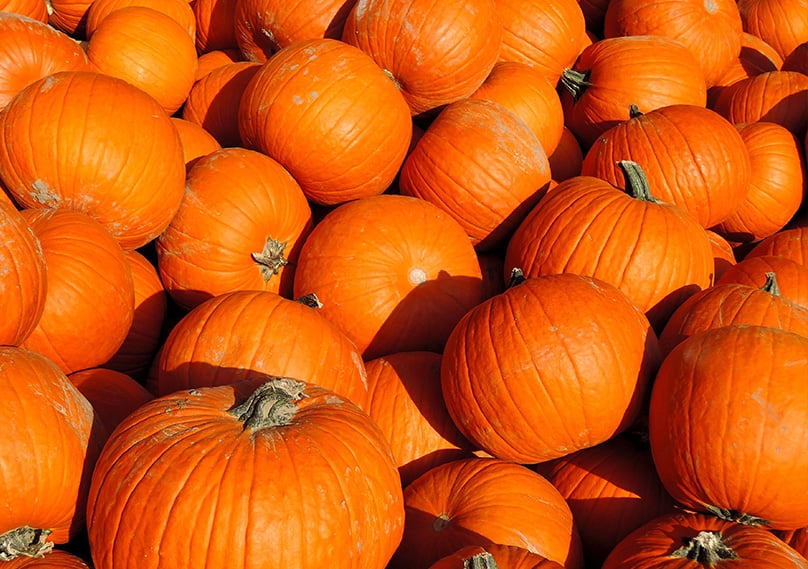
Some Native American tribes also dried out strips of pumpkin and used them to create woven mats.
Pumpkin was a very popular source of food among American colonists. One of the most popular ways that pumpkins were prepared by colonists was removing the tops, de-seeding the vegetables, and filling the inside of the squash with a mixture of milk, honey, and spices and then baked. This preparation is believed to be the origin of modern-day pumpkin pie.
Christopher Columbus took pumpkin seeds from the Americas back to Europe on one of his excursions to the New World. But, because pumpkins require warmth and their growing season is pretty long, the plants never really became as popular in northern European countries, as the temperatures of the summer season are not warm enough to support their growth.
Today, pumpkins are still used as a food crop; however, they are most commonly used for ornamental purposes. Pumpkins are a staple decoration of the fall season; they are particularly associated with Halloween and Thanksgiving.
Growing Pumpkins
Now that we’ve touched a bit on the history of pumpkins, let’s discuss how to grow these vegetables in your own garden.
Before you consider growing them, however, it’s important to make sure that you have enough space in your garden to accommodate them. Pumpkins grow on long vines that can reach 20 feet in length or longer.
Choose a location where the vines will have plenty of space to ramble. You can direct the vines where you want them to go when the plants are young; however, once they become established and begin to flower, the vines should be left alone.
If you don’t have a ton of space, you can still grow pumpkins, but you should opt for a smaller variety. Jack Be Little’s are a great option; however, they cannot be eaten and should only be used for their ornamental value.
If you don’t have a lot of space and want pumpkins that can be consumed, opt for sugar pumpkins. They grow to about 4 to 6 pounds, their flesh is sweet, and they aren’t as stringy inside as other type of pumpkins.
- Pumpkins Galore - Grow a variety of pumpkins in this fun mix of seeds for planting in your home vegetable garden. Casper, Small Sugar, Fairy Tale, and Jack-O-Lantern are four popular pumpkins that have earned their place in the American holiday harvest tradition for production and reliability.
- Carving and Culinary Uses - Each of these pumpkins is versatile as both a decorative and cooking pumpkin. Carve beautiful jack-o-lanterns for Halloween, but save the seeds to toast. You should have plenty of pumpkins for delicious baking, soups, and more culinary delights.
- Grow Now or Later - Plant now or store for future growing seasons. Will remain viable for years if stored in a cool dry location. Each packet has instructions for saving seeds so you can perpetuate your harvest and share with others.
- The Info You Need to Grow - The seeds are packed in a beautiful paper packet with instructions for successful and easy growing in your home garden. Each package also has instructions for saving seeds after harvest.
- Small American Family-Owned Business - We’re committed to providing fresh, high-quality pumpkin seeds for planting now or store for future growing seasons. We pledge to sell only safe, non-hybrid non-GMO heirloom seeds, always open-pollinated, untreated, and tested for the best germination rates.
- Contents - This mixture of seeds includes more than 7 varieties of Pumpkins. A blend of Jack O' Lantern, Blue Jarrahdale, Atlantic Giant, Fairytale, Small Sugar, Jack Be Little, Cumshaw Green Striped, Connecticut Fields, Cinderella, Howden & more!
- Harvest - The different varieties of pumpkins grown from this seed mixture will be ready for harvesting from 90 days to 125 days. Placing straw underneath the fruits as they mature can prevent rot.
- Note - Take note that larger seeds grow larger varieties of Pumpkins and smaller grow medium to miniature sized pumpkins. Smaller seeds produce shorter harvesting dates and vice versa.
- Quality - All Pumpkin seeds packaged by Seed Needs are intended for the current and the following growing seasons. All seeds are stored in a temperature controlled facility that is free of significant amounts of moisture.
- Quantity - Seed Needs offers generous quantities. You can share with friends and family, or you can save the extra seeds until the following season, if properly stored.
Last update on 2024-10-11 / Affiliate links / Images from Amazon Product Advertising API
When to Plant Pumpkins
- Pumpkins are heat-loving plants. As such, they should not be planted in the ground until the soil is warm enough and the risk of frost has ended.
- Typically, early June is the ideal time to plant pumpkins in most location.
- Pumpkins have a long growing season. If you live in a location where the soil will not be warm enough to support the plants throughout their entire growing season, you can begin your pumpkins indoors and transplant them when the ground has warmed enough and the risk of frost has passed.
- It’s recommended that you begin growing pumpkins indoors about 3 weeks before the weather outdoors is ideal for growing.
Where to Plant Pumpkins
- Pumpkins, as mentioned, are heat-loving plants, so make sure to choose a spot that receives plenty of sunlight.
- Space out the seeds you are planting according to the recommendations on the seed packet.
- To increase their success, consider growing the seeds in hills of dirt that are slightly raised off of the ground.
- Hills usually warm up a lot faster than flat ground.
- They drain water a lot faster, too. Planting in hills will also allow the vines to flow downward.
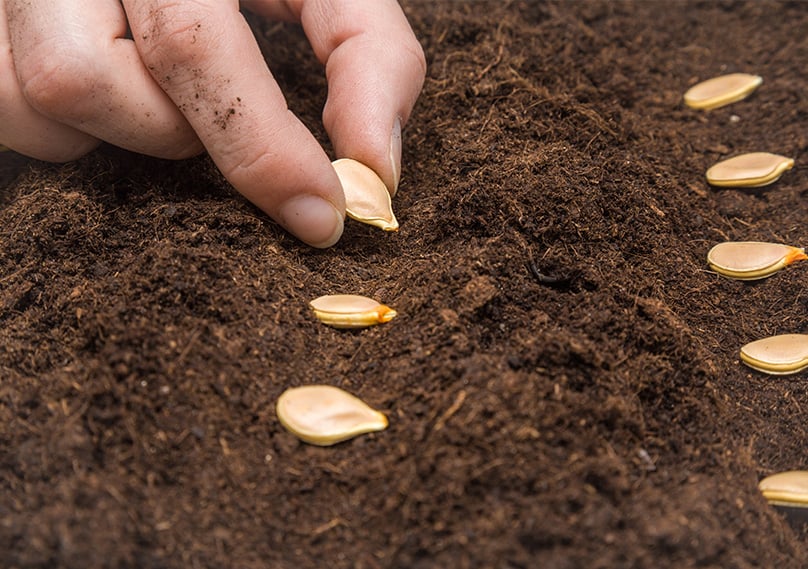
Soil Preparation for Pumpkins
Preparing the soil properly is crucial for the healthy growth and development of pumpkin plants. These plants thrive in rich, well-draining soil with a pH between 6.0 and 6.5. Here are some steps to follow for soil preparation before planting pumpkins:
- Choose the right location: Pumpkins require full sun for optimal growth, so select a spot in your garden that receives at least 6-8 hours of direct sunlight per day. Additionally, ensure there’s enough space for the vines to spread, as pumpkin plants can become quite large, depending on the variety.
- Test the soil pH: Before planting, test the soil pH to ensure it falls within the ideal range for pumpkins. If the pH is too low (acidic), you can raise it by adding lime to the soil. If the pH is too high (alkaline), you can lower it by incorporating sulfur or peat moss.
- Amend the soil: Pumpkins thrive in fertile, well-draining soil. If your soil is heavy clay or sandy, amend it with organic matter such as compost, well-rotted manure, or aged leaf mold. This will improve soil structure, drainage, and nutrient content, creating a more hospitable environment for pumpkin plants.
- Create planting mounds: To improve drainage and promote faster soil warming, create raised planting mounds for your pumpkin seeds or seedlings. Mounds should be about 12-18 inches high and 2-3 feet in diameter, with 4-6 feet between each mound, depending on the pumpkin variety. For vining pumpkins, leave 8-10 feet between mounds.
- Fertilize the soil: Pumpkins are heavy feeders and benefit from a nutrient-rich soil. Before planting, mix a balanced, slow-release fertilizer or organic alternative, such as composted manure, into the soil. Follow the package instructions for the appropriate application rate.
- Prepare for irrigation: Pumpkins need consistent moisture throughout the growing season, so it’s essential to have a reliable irrigation system in place. Drip irrigation or soaker hoses are ideal, as they deliver water directly to the roots and help minimize the risk of disease caused by wet foliage.
Feeding Pumpkins
Pumpkins are very heavy feeders, so you’ll want to make sure that you fertilize your plants. You can use an all-purpose fertilizer that is specifically formulated for vegetable gardens.
For the best results, feed your pumpkin plants every two weeks. You can also mix manure or compost into the soil regularly.
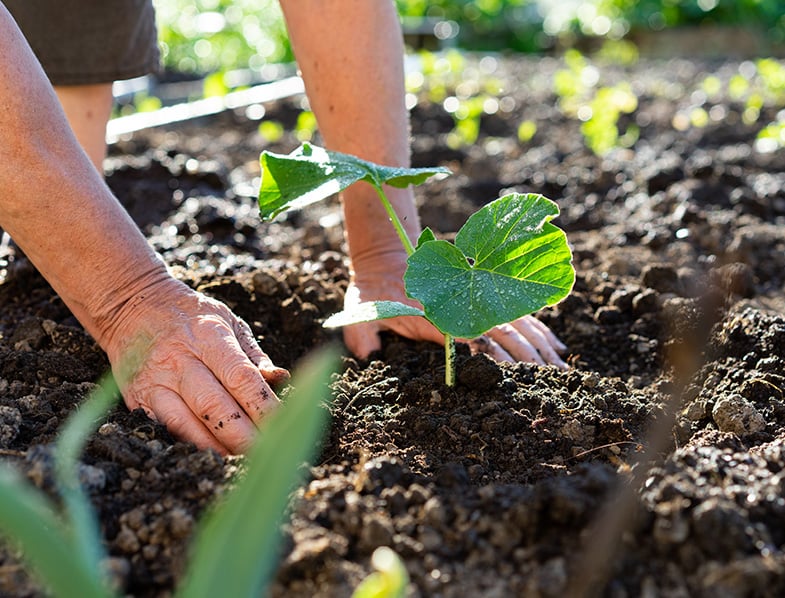
How to Water Pumpkins
- Pumpkins should receive deep, yet gentle watering once a week.
- Apply about 1 inch of water to the plants at a time; however, do adjust your watering according to the rain your area is receiving.
- If pumpkins are overwatered, they will rot. Do note that often, pumpkin leaves will look wilted in the heat of the day, even when their soil is still moist.
- As long as the leaves perk up again when the heat fades or when the sun goes under a cloud, you shouldn’t need to apply more water.
- Applying mulch to your beds will help to retain moisture in the soil. Additionally, mulch will help to keep weeds that could suck water away from your plants at bay.
- When watering your pumpkins, try to keep the foliage as dry as possible, unless it’s a very dry, sunny day. Dampness can lead to rot and can promote the development of disease.
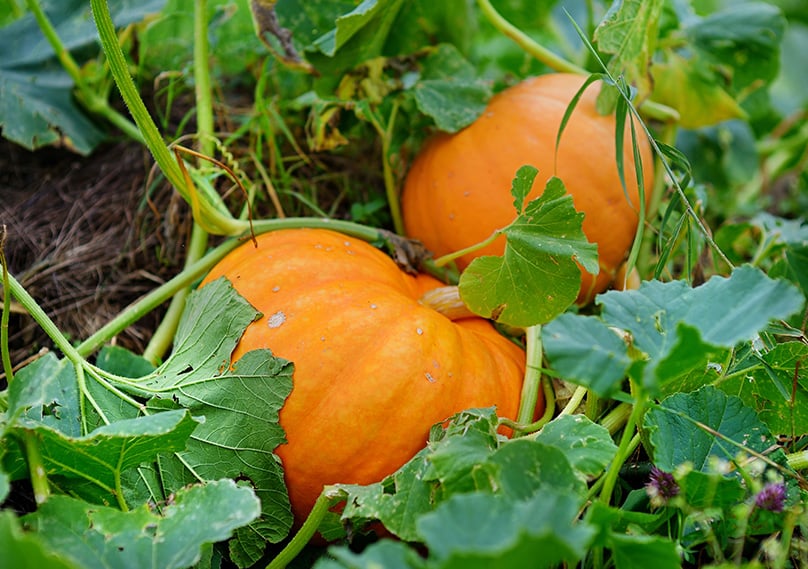
Pumpkin Pests and Diseases
Unfortunately, pumpkins are prone to some types of pests and diseases. Cucumber beetles are the most common pest problem. They love to eat the foliage of pumpkin plants and small seedlings will not be able to survive an attack from these pests.
Covering the plants with a garden fabric until they begin to flower will help to keep these pests at bay.
Other pest that can be problematic for pumpkins include squash-vine borers, aphids, cutworms, leafminers, and thrips.
Planting companion plants with your pumpkins – leeks, onion, and dill, for example – can help to keep pests at bay, as they deter them from the pumpkins.
As for disease, powdery mildew, downy mildew, gummy stem blight, white speck, and anthracnose can affect pumpkin plants, particularly in locations where the conditions are humid and wet.
To prevent disease, keep your patch well-weeded, as weeds can spread disease to the plants.
Pumpkin Growing Tips and Tricks
In addition to the above-mentioned information, here are some helpful tips and tricks that you can use to promote healthier pumpkin growth.
- As the pumpkins begin to grow on the vines, keep them off the ground using supports. This will help to promote even coloring and prevent rot. Alternatively, you can rotate the fruit once a week or so to ensure that the plant takes a good shape, ensure even coloring, and prevent rot.
- Bees are vital for pollination, so be sure that you aren’t using an insecticide that will kill off pees. If you must apply one, only do so in the later afternoon or early evening hours when the blossoms have closed up for the day. You can attract more bees to your pumpkins by adding a bee house to your garden.
- While pumpkin vines can be obstinate, they are actually quite delicate. Make sure that you use caution so that you don’t damage the vines. Damaged vines reduces the quality of the pumpkins that will grow.
- Pinch off the fuzzy ends of the vines after a few pumpkins have formed to prevent vine growth so that the plant can focus its energy on forming the fruit.
- To prevent decay and damage from insects, place a piece of heavy cardboard or a thin board underneath your pumpkins as they ripen.
Harvesting Your Pumpkins
After a few months of growth, pumpkins will reach their full maturity. They are ready to pick when their rinds are hardened and they have achieved the coloring that you desire.
You’ll want to harvest your crop before the firs heavy frost, as heavy frost damages pumpkins. When harvesting, use pruning shears to cut the pumpkin from the vine several inches from where it is attached to the stem.

Varieties of Pumpkins
Pumpkins come in a wide range of shapes, sizes, colors, and flavors, making them a versatile and interesting addition to any garden. Understanding the different varieties of pumpkins can help you choose the right ones for your needs, whether it’s for carving, cooking, or ornamental purposes. Here are some popular varieties of pumpkins:
Carving Pumpkins:
- Connecticut Field: This is a classic pumpkin variety used for carving Jack-o’-lanterns. It typically weighs between 15-25 pounds and has a deep orange color, with a thick, sturdy rind and a relatively flat bottom for stability.
- Howden: Another popular variety for carving, the Howden pumpkin has a deep orange color, strong stem, and thick walls that hold up well when carved. They can weigh between 15-30 pounds and have a slightly elongated shape.
Pie Pumpkins:
- Sugar Pie: As the name suggests, this small, round pumpkin variety is perfect for making pies. It has a sweet, smooth-textured flesh and weighs around 4-6 pounds. Sugar Pie pumpkins are less stringy than carving pumpkins, making them ideal for cooking.
- Winter Luxury: This heirloom variety is also well-suited for pies, with sweet, smooth flesh and a unique netted skin pattern. Winter Luxury pumpkins typically weigh 5-7 pounds and have an attractive appearance for decorative purposes as well.
Miniature Pumpkins:
- Jack Be Little: This small, decorative pumpkin variety weighs around 8 ounces and has a flat, ribbed shape with a deep orange color. Jack Be Littles are great for crafts and fall decorations but are not suitable for eating.
- Baby Boo: Baby Boo pumpkins are tiny, white pumpkins that weigh around 1-2 pounds. Their unique appearance makes them perfect for decorating, and their small size means they don’t take up too much space in the garden.
Specialty Pumpkins:
- Cinderella: This heirloom variety is named after the shape of Cinderella’s coach in the classic fairy tale. Cinderella pumpkins have a deep red-orange color and a flattened, ribbed shape. They can weigh between 20-35 pounds and are suitable for both cooking and decoration.
- Blue Hubbard: This pumpkin variety has a striking blue-gray color and a large, rounded shape. Blue Hubbards can weigh anywhere from 15-40 pounds and have a sweet, fine-textured flesh that is excellent for baking and soups.
When choosing pumpkin varieties for your garden, consider factors such as available space, desired uses, and the length of the growing season in your area. By selecting the right varieties, you can enjoy a successful and bountiful pumpkin harvest.
Conclusion
Growing pumpkins can be a rewarding and enjoyable experience for gardeners. With their rich history and versatile uses, pumpkins make an excellent addition to any garden.
By understanding the different varieties, preparing the soil properly, and providing the appropriate care, you can successfully cultivate your own pumpkin patch.
Remember to follow the essential tips for planting, watering, fertilizing, and pest control, and enjoy the satisfaction of harvesting your own homegrown pumpkins for culinary and decorative purposes alike.
Pumpkin Growing FAQs
What is the trick to growing pumpkins?
The trick to growing pumpkins is providing well-draining, nutrient-rich soil, sufficient sunlight, regular watering, and appropriate fertilization. Also, be sure to choose the right variety for your garden space and monitor for pests and diseases.
How long does it take to grow a pumpkin?
It takes about 90 to 120 days for a pumpkin to grow from seed to maturity, depending on the variety.
Where do pumpkins grow best?
Pumpkins grow best in full sun (6-8 hours per day), with well-draining, nutrient-rich soil, and a pH of 6.0 to 6.5.
Do pumpkins come back every year?
Pumpkins are annual plants, meaning they complete their life cycle in one growing season and do not come back every year. However, if you save the seeds from your harvested pumpkins, you can plant them again the following year.
Should I cut off dying pumpkin leaves?
You can remove dying or damaged pumpkin leaves to promote air circulation and prevent diseases. However, be cautious not to damage healthy foliage or vines in the process.
Should you turn pumpkins as they grow?
Turning pumpkins as they grow can help promote even coloring and prevent flat spots. However, be gentle when turning to avoid damaging the fruit or vine.
Should I water pumpkins every day?
No, pumpkins should be watered deeply but gently once a week, providing about 1 inch of water at a time. Adjust your watering schedule according to rainfall in your area.
Should you water pumpkin plants every day?
You should not water pumpkin plants every day. Instead, provide deep, gentle watering once a week, adjusting for local rainfall.
Do pumpkins like a lot of water?
Pumpkins require regular watering, but they don’t like to sit in soggy soil. Provide deep, gentle watering once a week, ensuring that the soil doesn’t become waterlogged.
Sources & Further Reading
- https://www.rhs.org.uk/vegetables/pumpkins/grow-your-own
- https://web.extension.illinois.edu/pumpkins/growing.cfm
- https://www.thompson-morgan.com/how-to-grow-pumpkins
- https://www.goodhousekeeping.com/home/gardening/a28367017/growing-pumpkin-plants/
- https://bonnieplants.com/blogs/how-to-grow/growing-pumpkins
- https://www.almanac.com/plant/pumpkins

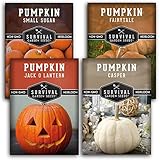
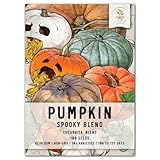
7 Comments
I found some good advice on growing pumpkins. This year mine are small but hope to do better and bigger next year
Pumpkins are an Excellent food source for the herd of deer’s on our property. We grow them specifically for them so they have food through out the winter months. It’s entering to watch the does and there young enjoy the fruit. A 4-6 lb. pumpkin doesn’t stand a chance when a hungry deer is around.
Sometimes I will pick a pumpkin or two when the color is just starting to develop on the pumpkin. Once the coloring begins it will not grow any larger. For me this is especially helpful when they are beginning to ripen while the weather is still hot and humid, The ripening will continue after the pumpkin is picked and I bring it into a fairly cool and less humid environment to avoid the risk of rot on the vine. I think this might help those who feel that they may get a heavy frost or freeze in their area before a pumpkin could ripen completely.
After the pumpkin plants that are started in doors are getting 3 to 4 inches long can they be planted outdoors and if-so do you put all the vine to the leave in the ground like a tomato or just the part that was seeded in the small starting pot?
Hi Hollie,
We have had a garden for the last 7 years. It measures 16′ x 30 feet and we taught ourselves to grow all manner of goodness. When harvest came, we learned how to can all we could, to enjoy it all winter long. Salsa, pickles, tomatoes, spag sauce, etc… In other words, it was our hobby and love. The garden was also a great place to chuck all we didn’t use, including October jack-o-lanterns. Everything would break down over winter and be tilled in, when spring arrived.
Fast forward and I now have a spinal disease and she needs a knee replacement. Such is life and you make adjustments right? Bend is not your friend.
So this year we decided to turn our garden into a cement patio. We could still be where we loved to be, just with less toil.
So we did that and in the process, you have to dig out soil and pile it along the sides so you can level where the cement will be poured. Cool, now we have raised beds to ring the patio with flowers and plants. Win, Win.
Well, we unearthed ancient demons. Ones with sharp teeth. Some with maniacal grins, some that just smiled, but you could tell they meant no good. The piles along all sides of the patio were rife with pumpkin seeds.
We began seeing shoots and yanked them. Whatever they were would eat all the flower nutrients. Then we got tons of rain, and they made it apparent that not only were they back from the dead, but they planned on sticking around.
So we decided to let them and see what would happen.
It is now August 10th 2021 and they have taken over our yard and patio. There are tendrils that are close to if not least 20ft…..in all directions. We have a white one that is the size of a beach ball in August and fear how much bigger it may get. In all there must be 30-40 of them doing beyond well, as the rains keep coming here in Northeast Michigan. They look beautiful and like a jungle surrounding the patio, but how much more can we expect and can we tame them in anyway? It is getting to the point that if we don’t play “The Great Pumpkin Charlie Brown” when we watch movies on the barn wall, they start to wriggle, and that cannot mean anything good.
Any ideas or help you could email us would be appreciated.
Just know, if we respond with requests for votive candles and child safe knives……it’s not us……RUN!
Thank you and love your site.
Steven and Trina
I’ve planted pumpkin seeds for years, and have consistently gotten healthy vines, beautiful blooms…but no actual pumpkins. I mean, not one. Anybody have any idea why this might be the case?
I read that it is more likely to be poor pollination. It has happened to me at least three times. Now maybe we can fix it and do better! Annette